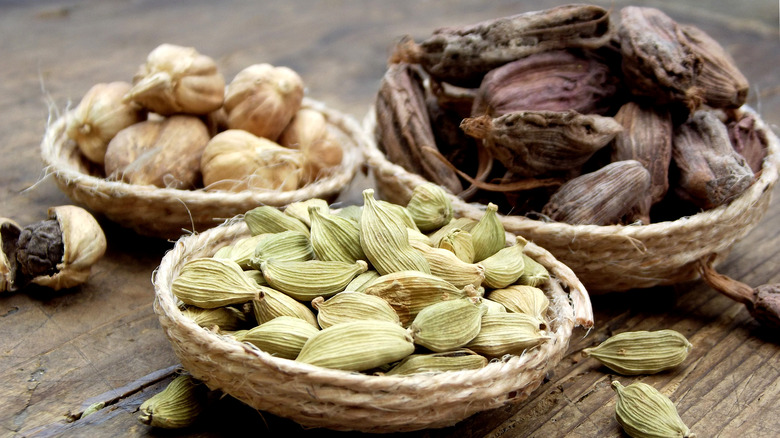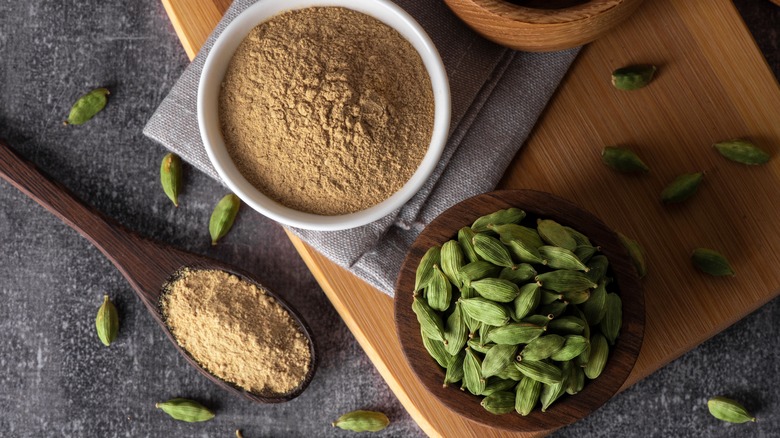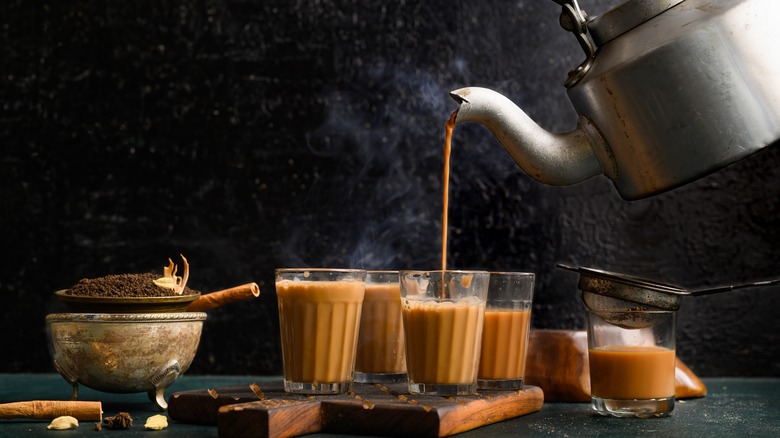The Main Difference Between White And Black Cardamom
Nicknamed the Queen of Spices because it's the third most expensive spice, cardamom is enjoyed all around the world in various forms and recipes. What some cooks may not know is that there are two distinct types of cardamom: black cardamom and white (a derivative of green). Their main difference? Harvesting.
Cardamom comes from the seeds within the pods of a cardamom plant, a member of the ginger family, and it originated in Southern India. Though they come from two different cardamom plants — green and black — the pods do not grow in two different colors. The color actually refers to the stage in the maturation process of the pod. Green cardamom is harvested before it reaches maturity, while black cardamom is harvested late and then roasted over a fire pit.
The harvesting matches the flavor distinction of each type, with green cardamom being naturally sweeter, while black cardamom has a smokier taste even before being roasted. It's worth clarifying that while green cardamom is the official variety, it's not what you typically find in stores. Instead, you're more likely to find white cardamom, which is simply the bleached form of the green pod.
Other key differences between white and black cardamom
Difference in harvesting leads to a world of other distinctions that makes this spice diverse. The first key difference: flavor. Black cardamom is the smokier and richer of the two thanks to its maturity and trip to the fire pit. Its flavor has hints of menthol that make it ideal for savory dishes. Meanwhile, white/green cardamom is the sweeter form, with an overall piney taste and notes of mint and lemon. Bleaching it white makes it milder, hence why this variety is used more commonly in baked goods.
Another key difference is where these spices are grown and used. India and Sri Lanka grow both varieties of cardamom, yet more often use black for a powerful flavor in their curries and famous chai. Green cardamom is largely grown in Guatemala, where it's used to flavor chewing gum. Popular in Nordic cuisines, Sweden consumes a large share of white cardamom, where it's used in pastries, primarily their iconic sweet bun, kardemummabullar.
A final difference is how they're prepared and used. White cardamom being the bleached form of green cardamom, it's more processed than black, and most often comes in a powdered form. On the other hand, black cardamom is almost always used in its full form, pod and all, to flavor recipes. This means that white cardamom powder is typically mixed into things like batters while black cardamom pods steep in heavier savory dishes and hot drinks and then are removed.
When to use white and black cardamom
Now that you have a handle on the flavors of the two kinds of cardamom, let's put your knowledge to good use. Black cardamom is the warmer of the two varieties and its savory-leaning taste makes it perfect for a rich dinner. As is tradition in India and other southeast Asian countries, black cardamom goes great in chicken curry, a lentil stew, or even as an enhancement to your basmati rice. Note that if you're using the whole cardamom pod, you'll want to remove it before eating because without being ground, the pods will be too crunchy and harsh.
After such a hearty meal you'll of course need dessert, and cardamom flavored sweets are on the menu. See how well white cardamom ups the flavor of fruit and try a cardamom peach cobbler, or explore Scandinavian sweets and make cardamom cookies. The fresh yet honeyed taste of white cardamom will perfectly complement any sugary delight. And then you can wash it all down with a classic cardamom chai.


